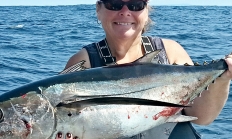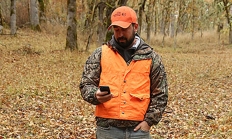Search myodfw.com
Showing 81 - 100 of 287 results
Article
A growing number of people take to the woods in winter, looking for antlers that have been shed by Oregon’s deer and elk. This also is a critical time for big game, and shed hunting responsibly can help protect vulnerable animals.
Article
Pronghorn antelope are the fastest ungulates in North America and can reach speeds of up to 40 miles an hour. Oregon has about 25,000 pronghorn antelope, which are native to the Columbia Plateau and the High Desert shrublands of eastern Oregon.
March 2, 2019

Article
Bighorn sheep and Rocky Mountain goat the rarest game mammals in Oregon today, with less than 100 bighorn sheep tags and 20 Rocky Mtn goat tags offered in 2015. The tags are “once-in-a-lifetime” so hunters who draw them can’t draw them again.
March 2, 2019

Article
Didn't draw a big game tag this year? Here are some other ways to have a great hunting season.

Article
Albacore tuna fishing can offer nonstop action landing fast-moving, hard-fighting fish. Charter trips make tuna fishing accessible to all anglers. In addition, many well-equipped private boat anglers have been making the long trips offshore. If you don't see tuna fishing for yourself, we've even included a brief video on how to buy fresh Oregon tuna from a commercial fisherman at the dock.

Article
Ask 10 anglers how to fish and you’re likely to get 10 different answers. However, there are a few types of fishing rigs that almost everyone can agree on – they’re both simple and effective. Here are 16 of some of our favorite rigs for warmwater species.
July 31, 2020

Article
Each year, thousands of fish are harvested illegally in Oregon. Anglers who wait all year for their favorite salmon or steelhead run shouldn’t face reduced opportunity because of poaching. To report poaching call *OSP or 1-800-452-7888
July 31, 2020

Article
Hiking or camping plans getting in the way of fishing this weekend? Going to be busy kayaking or going to the beach? No need to choose between fishing and other fun – just take a rod with you.

Article
Desktop scouting, trail cameras and 5 other scouting tips

Article
Better known for their elaborate courtship displays, greater sage-grouse also offers the wingshooter a unique hunting experience. This is a small, well-regulated hunt by permit only. Permit applications are due in mid-August each year. Apply for a permit
August 18, 2025

Article
The Buoy 10 fishery, where the Columbia River meets the Pacific, offers anglers a chance to catch Chinook and coho salmon fresh from the ocean.

Article
Look for collection barrels where you hunt. Data gathered from wings and tails helps ODFW biologists look at population productivity and set seasons.

Article
Oregon’s population of about 6,000 cougars occupies a wide variety of habitat across the state, offering a year-round, readily-accessible hunting opportunity.
August 29, 2019

Article
The ODFW electronic licensing system makes it easy to tag your harvests for salmon, steelhead and halibut, as well as your deer and elk on your phone. Here are some tips for completing the task.
September 5, 2025

Article
In late September, deer and elk begin their annual migration to wintering grounds, and often have to cross roads and highways to get there. Here are 7 tips to help avoid a collision.

Article
Change up your tactics to take more early season birds.
August 21, 2025

Article
Minimal gear, aggressive fish and plenty of bank fishing opportunity – just three reasons to try coho fishing.

Article
The Pikeminnow Sport Reward Fishery Program, funded by the Bonneville Power Administration and administered by the Pacific States Marine Fisheries Commission, pays anglers for each northern pikeminnow that they catch in the Columbia River.
Article
See the Oregon records for both coldwater and warmwater game fish. And, find the forms to submit if you think you've caught a new record!
December 6, 2019
Article
Trout are Oregon's most popular game fish but there are several species and not all are open to fishing. Learn how to identify them correctly, and find some tips for catching them too.

